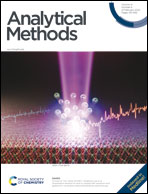Multiple heteroatom-doped photoluminescent carbon dots for ratiometric detection of Hg2+ ions in cell imaging and environmental applications†
Abstract
Photoluminescence detection and imaging of Hg2+ ions in the biochemical living system are of great importance. In this study, a new photoluminescent probe based on nitrogen (N), sulfur (S), and boron (B) multiple heteroatom co-doped carbon dots (NSB-CDs) is synthesized for the ratiometric detection of Hg2+ ions. The prepared NSB-CDs possess good aqueous solubility, excellent pH and ionic stability, excitation dependency, and high quantum yield (QY = 17.6%). The ratiometric photoluminescent sensor NSB-CDs exhibit high selectivity, sensitivity, and interference towards Hg2+ ions over other metal ions. After adding Hg2+ ions, the emission intensity of the NSB-CDs exhibits a large redshift from 452 to 496 nm (up to 44 nm), corresponding to a notable change from blue to green emission in aqueous solutions. The association constant (Ka), the limit of detection (LOD), and the limit of quantification (LOQ) for NSB-CDs/Hg2+ complex are calculated to be 3.6 × 104 M−1, 3.1 × 10−9 M, and 10.4 × 10−9 M, respectively, in the range of 0−30 × 10−6 M. The live cell bioimaging of HCT-116 cells with NSB-CDs validates the application of multicolor imaging for the detection of Hg2+ ions in aqueous media and biological systems. Moreover, the potential use of the NSB-CDs/Hg2+ complex for real sample analysis is demonstrated.



 Please wait while we load your content...
Please wait while we load your content...